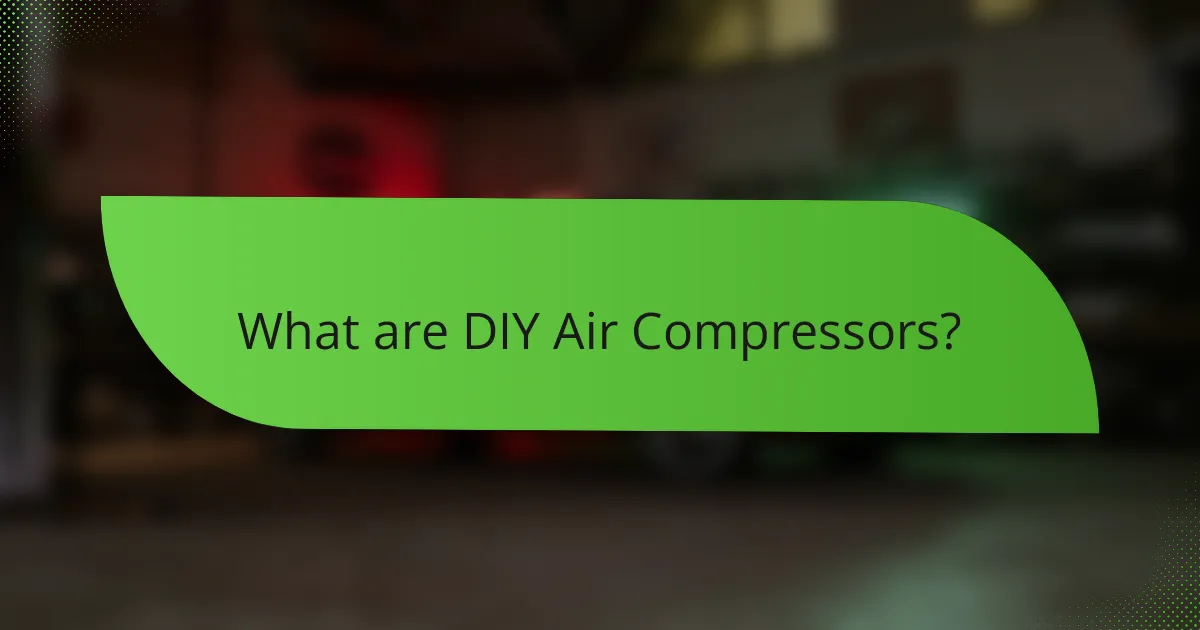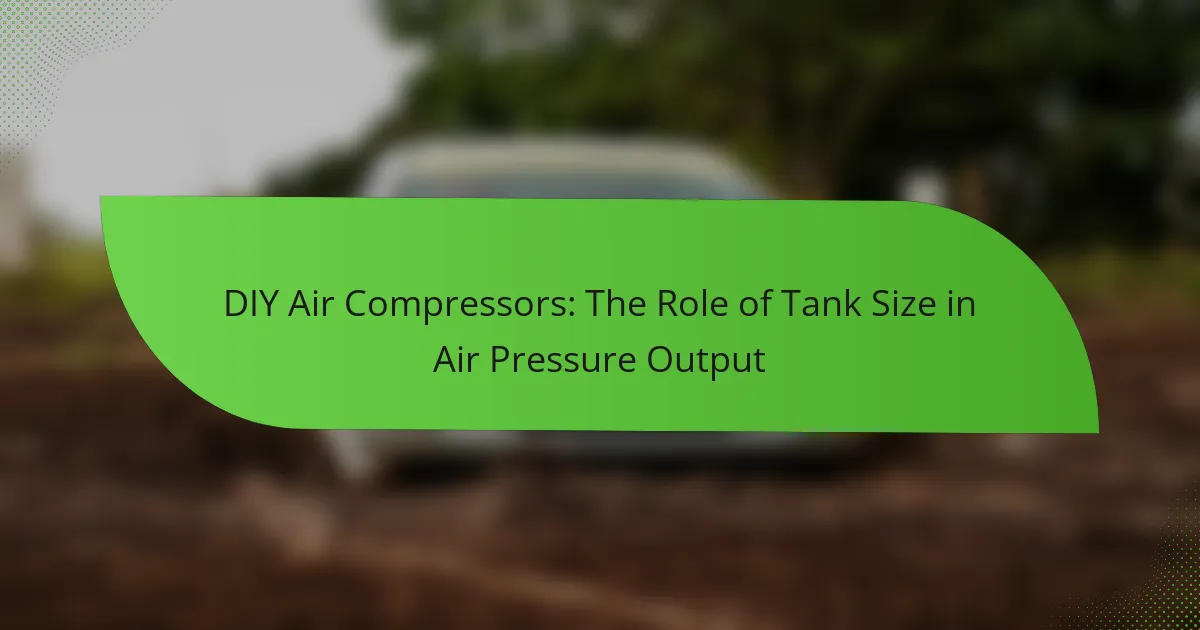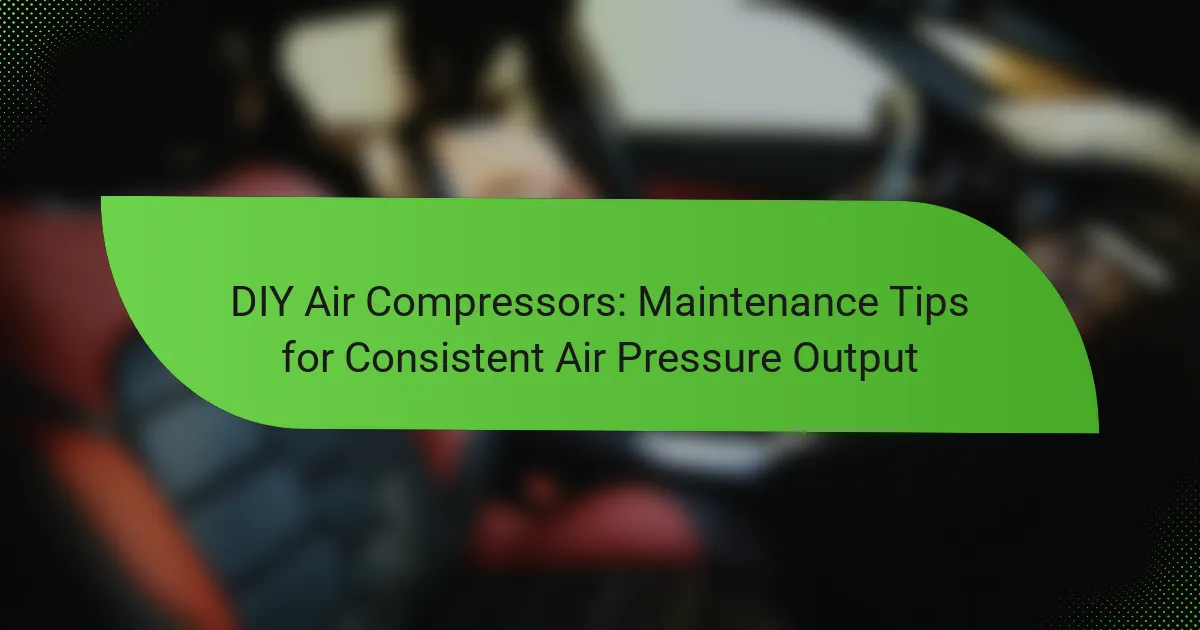DIY air compressors are devices created by individuals to compress air for various applications, comprising essential components such as a motor, pump, and storage tank. This article explores the critical factors influencing air pressure output, including compressor type, tank size, and regulator settings. It highlights the importance of proper assembly, maintenance, and upgrades to optimize performance and safety. Additionally, it discusses how ambient temperature affects air density and pressure efficiency. Understanding these elements is crucial for effective air pressure management in DIY air compressors, enhancing their utility for tasks like inflating tires and powering pneumatic tools.

What are DIY Air Compressors?
DIY air compressors are devices constructed by individuals to compress air for various applications. They typically consist of a motor, a pump, and a storage tank. The motor powers the pump, which draws in air and compresses it. This compressed air is then stored in the tank for later use. DIY air compressors can be built from repurposed materials or purchased components. They serve purposes such as inflating tires, powering pneumatic tools, and spraying paint. The efficiency and output of a DIY air compressor depend on its design and components. Proper assembly and maintenance are crucial for optimal performance and safety.
How do DIY Air Compressors function?
DIY air compressors function by converting mechanical energy into compressed air. They typically use an electric motor or gas engine to drive a piston or diaphragm. This action compresses air into a storage tank. The compressed air can then be released for various applications, such as powering tools or inflating tires.
The efficiency of a DIY air compressor relies on its components, including the motor size, tank capacity, and the design of the compression mechanism. For instance, a larger tank can hold more air, resulting in more extended use before needing to refill. Additionally, the quality of the seals and valves affects air retention and pressure output.
Research indicates that the design and materials used in the compressor significantly influence its performance and durability. Regular maintenance, such as checking for leaks and ensuring proper lubrication, also enhances functionality.
What are the key components of a DIY Air Compressor?
The key components of a DIY air compressor include a motor, a pump, a tank, and pressure regulation components. The motor powers the pump to compress air. The pump is responsible for drawing in air and increasing its pressure. The tank stores the compressed air for later use. Pressure regulation components maintain a consistent output pressure. Each component plays a vital role in the efficiency and functionality of the air compressor.
How does each component influence air pressure output?
The components of an air compressor influence air pressure output in distinct ways. The motor generates power to drive the compressor. A stronger motor produces higher pressure output. The pump compresses air and determines the volume of air output. A larger pump can compress more air, increasing pressure. The tank stores compressed air and affects the pressure stability. A larger tank maintains pressure longer during usage. The pressure switch regulates the compressor operation. It ensures the compressor turns on and off at set pressure levels. The valves control airflow and can impact efficiency. Well-designed valves minimize pressure loss during operation. Each component works together to optimize air pressure output.
Why choose DIY Air Compressors over commercial options?
DIY air compressors offer customization and cost-effectiveness compared to commercial options. They allow users to select specific components tailored to their needs. This customization can lead to enhanced performance and efficiency. DIY models can be assembled with readily available parts, reducing initial investment costs. Additionally, users can repair or upgrade their compressors easily, extending the product’s lifespan. According to a study by the National Institute of Standards and Technology, DIY air compressors can achieve similar performance levels to commercial units when built correctly. This makes DIY options a practical choice for those seeking flexibility and savings.
What are the cost benefits of building your own Air Compressor?
Building your own air compressor can lead to significant cost benefits. Firstly, you can save money on labor costs since you are doing the work yourself. Secondly, sourcing parts individually often costs less than buying a pre-assembled unit. Thirdly, you can select high-quality components that may extend the lifespan of the compressor, reducing long-term replacement costs. Additionally, custom-built compressors can be tailored to specific needs, avoiding unnecessary features that inflate prices. According to a study by the Home Improvement Research Institute, DIY projects can save homeowners up to 30% compared to retail prices. This combination of savings on initial investment and potential longevity makes building your own air compressor financially advantageous.
How does customization play a role in DIY Air Compressors?
Customization significantly enhances the functionality and efficiency of DIY air compressors. It allows users to tailor components to specific tasks or applications. For instance, adjusting tank size can optimize air storage for different projects. Modifying the motor can increase power output, improving performance. Additionally, users can select specific fittings and hoses to suit their tools. This adaptability leads to improved pressure output and operational efficiency. Customization can also result in cost savings by allowing users to build compressors that meet their exact needs without unnecessary features. Ultimately, personalization in DIY air compressors empowers users to achieve better results in their projects.

What essential components influence air pressure output?
The essential components that influence air pressure output include the compressor type, tank size, and regulator settings. The compressor type affects the method of air compression. Common types are reciprocating and rotary screw compressors. Tank size determines the volume of air stored, impacting pressure stability. Larger tanks can maintain pressure longer during usage. Regulator settings control the output pressure delivered to tools. Proper adjustment is crucial for optimal performance. Additionally, ambient temperature can affect air density and pressure output. Higher temperatures may lead to decreased air pressure efficiency. Understanding these components is vital for effective air pressure management in DIY air compressors.
How do air tanks affect pressure in DIY Air Compressors?
Air tanks store compressed air and directly influence pressure in DIY air compressors. The pressure within an air tank is determined by the amount of air compressed and the tank’s volume. As air is compressed into the tank, the pressure increases according to Boyle’s Law, which states that pressure and volume are inversely related. A larger air tank can hold more air at a lower pressure, while a smaller tank may reach higher pressures quickly but hold less air.
When the compressor operates, the tank releases stored air, maintaining a consistent pressure for tools and equipment. If the tank is too small, the compressor may struggle to keep up with demand, leading to pressure drops. Conversely, a properly sized tank helps stabilize pressure during usage.
Maintaining adequate pressure is crucial for efficient tool operation. For example, a pressure of 90-120 PSI is common for many pneumatic tools. Therefore, the air tank’s capacity and pressure rating significantly affect the overall performance of DIY air compressors.
What sizes and materials are best for air tanks?
The best sizes for air tanks range from 1 to 80 gallons. Smaller tanks, around 1 to 6 gallons, are ideal for light tasks like inflating tires. Medium tanks, from 6 to 20 gallons, suit general DIY projects. Larger tanks, over 20 gallons, support more demanding applications like spray painting.
Regarding materials, steel and aluminum are the most common. Steel tanks are durable and resistant to damage. Aluminum tanks are lightweight and corrosion-resistant. Both materials can handle high pressure effectively.
The choice of size and material impacts the air tank’s performance and longevity. A study by the American Society of Mechanical Engineers indicates that the material significantly affects the tank’s pressure rating and lifespan.
How does tank pressure relate to performance?
Tank pressure directly influences the performance of air compressors. Higher tank pressure allows for greater air delivery and power for tools. It enhances the compressor’s ability to maintain consistent airflow. This is crucial for tasks that require sustained pressure, such as spray painting or pneumatic tools. Conversely, low tank pressure can lead to inadequate performance and tool inefficiency. For example, a tank pressure of 90 PSI can effectively power most pneumatic tools. Therefore, maintaining optimal tank pressure is essential for achieving desired performance levels.
What role do compressors play in air pressure output?
Compressors are essential devices that increase air pressure output. They achieve this by reducing the volume of air, which raises its pressure according to Boyle’s Law. As the compressor operates, it draws in ambient air and compresses it into a smaller space. This process results in a higher pressure of the air being released. For example, a typical air compressor can generate pressures ranging from 30 to 120 psi. This increased pressure is crucial for powering pneumatic tools and inflating tires. The efficiency of compressors directly affects the air pressure output they can achieve.
What types of compressors are commonly used in DIY projects?
The types of compressors commonly used in DIY projects include reciprocating compressors, rotary screw compressors, and diaphragm compressors. Reciprocating compressors are popular for their affordability and versatility. They are suitable for various tasks, such as inflating tires and powering pneumatic tools. Rotary screw compressors offer continuous airflow and are ideal for larger projects requiring sustained pressure. Diaphragm compressors are favored for low-pressure applications and are often used in spray painting and airbrush work. These compressors are chosen based on specific project needs, ensuring efficiency and effectiveness in DIY tasks.
How do compressor specifications impact air pressure?
Compressor specifications directly impact air pressure output. The maximum pressure rating indicates the highest pressure the compressor can achieve. A higher maximum pressure allows for more versatile applications. The compressor’s CFM (Cubic Feet per Minute) rating affects the volume of air delivered at a given pressure. Higher CFM ratings can maintain pressure during demanding tasks. Motor power also plays a critical role; more powerful motors can generate higher pressures. Additionally, tank size influences pressure stability; larger tanks can store more compressed air. These specifications collectively determine the efficiency and effectiveness of the compressor in various tasks.
How do regulators and valves contribute to air pressure control?
Regulators and valves are crucial for controlling air pressure in systems. Regulators maintain a consistent output pressure regardless of changes in input pressure. They achieve this by automatically adjusting the flow of air to match the desired pressure setting. Valves, on the other hand, control the flow and direction of air within the system. They can open or close to either allow or restrict airflow, thus influencing pressure levels. Together, regulators and valves ensure that air pressure remains stable and within specified limits. This stability is essential for the efficient operation of air compressors and connected tools.
What types of regulators are available for DIY Air Compressors?
There are several types of regulators available for DIY air compressors. The most common types include pressure regulators, flow regulators, and combination regulators. Pressure regulators maintain a consistent output pressure regardless of fluctuations in input pressure. Flow regulators control the rate of airflow to specific tools or applications. Combination regulators integrate both pressure and flow control in a single unit for versatility. Each type serves a specific purpose in managing air pressure and flow effectively in DIY projects.
How do valves affect airflow and pressure management?
Valves control airflow and pressure in air compressors by regulating the movement of air. They can either allow or restrict air passage based on their design and function. This regulation is crucial for maintaining the desired pressure levels within the system. For example, intake valves open to let air in during the compression cycle. Conversely, exhaust valves open to release air when the pressure exceeds a set limit. Proper valve function ensures efficient operation and prevents pressure loss. Studies show that malfunctioning valves can lead to significant drops in pressure and airflow efficiency. This highlights the importance of regular maintenance and inspection of valve components in air compressors.

How can I optimize my DIY Air Compressor for better performance?
To optimize your DIY air compressor for better performance, ensure proper maintenance and upgrades. Regularly check and replace air filters to maintain airflow efficiency. Inspect and tighten all connections to prevent air leaks, which can reduce pressure. Upgrade the compressor motor to a higher horsepower model for increased output. Use a larger air tank to store more compressed air, enhancing performance during use. Implement a moisture separator to prevent water accumulation in the air lines, which can affect tools and equipment. Additionally, consider using high-quality hoses that can withstand higher pressures and improve airflow. These steps collectively enhance the overall efficiency and performance of your DIY air compressor.
What maintenance practices enhance air pressure output?
Regular maintenance practices enhance air pressure output in air compressors. Cleaning or replacing air filters ensures unobstructed airflow. Inspecting and tightening fittings prevents air leaks, which can diminish pressure. Lubricating moving parts reduces friction, improving efficiency. Draining moisture from the tank avoids corrosion and maintains optimal performance. Checking the pressure switch ensures proper activation at set levels. Regularly servicing the compressor according to the manufacturer’s guidelines prolongs lifespan and maintains output. These practices collectively contribute to sustained air pressure levels in DIY air compressors.
How often should I check and replace components?
You should check and replace components of DIY air compressors every 3 to 6 months. Regular maintenance ensures optimal performance and longevity. Key components to monitor include filters, hoses, and oil levels. Filters should be inspected for clogs or damage. Hoses should be checked for leaks or wear. Oil levels must be maintained according to manufacturer guidelines. Following these intervals can prevent costly repairs and maintain air pressure output. Regular checks align with industry best practices for equipment maintenance.
What troubleshooting tips can improve compressor efficiency?
Regular maintenance can significantly improve compressor efficiency. Check the air filter regularly and replace it if it’s dirty. A clean filter allows for better airflow, reducing strain on the compressor. Inspect the oil level and change it according to the manufacturer’s guidelines. Proper lubrication minimizes friction and enhances performance. Ensure that all connections are tight to prevent air leaks. Leaks can cause the compressor to work harder, wasting energy. Monitor the ambient temperature and avoid operating the compressor in extreme conditions. High temperatures can reduce efficiency. Lastly, keep the compressor clean and free from debris. A clean unit runs more efficiently and lasts longer.
What are the best practices for building a DIY Air Compressor?
Use a suitable motor for your DIY air compressor. A motor should provide sufficient power, typically between 1 to 5 horsepower. Select an appropriate air tank. The tank should be rated for the pressure you intend to use, often around 90-150 PSI. Incorporate a compressor pump designed for your desired pressure and flow rate. The pump must be compatible with the motor’s horsepower. Ensure proper ventilation for heat dissipation. Adequate airflow prevents overheating during operation. Use quality fittings and hoses to minimize leaks. Leaks can significantly reduce efficiency and performance. Install a pressure regulator for consistent output pressure. This helps maintain the desired pressure for various applications. Include safety features such as pressure relief valves. These prevent over-pressurization, enhancing safety during use. Follow local electrical codes when wiring the motor. This ensures safe and compliant operation.
What safety measures should I consider during assembly?
Ensure proper ventilation during assembly to prevent inhalation of harmful fumes. Use safety goggles to protect your eyes from debris. Wear gloves to shield your hands from sharp edges and hot surfaces. Keep a first aid kit nearby for emergencies. Secure all components tightly to avoid accidents during operation. Follow manufacturer instructions for tools and components to ensure safe assembly practices. Always turn off the power supply before making adjustments to avoid electric shock. These safety measures minimize risks during the assembly of DIY air compressors.
How do I test my DIY Air Compressor for optimal performance?
To test your DIY air compressor for optimal performance, first ensure it is properly assembled and connected. Check for any air leaks in the hoses and fittings. Use a pressure gauge to measure the output pressure. Run the compressor and observe the pressure readings. The compressor should reach its specified maximum pressure, typically between 90 to 120 PSI for many models. Monitor the compressor’s cycle time, noting how long it takes to fill the tank. A well-functioning compressor should refill quickly and efficiently. Additionally, assess the noise level during operation; excessive noise may indicate mechanical issues. Regularly inspect the air filter and oil levels if applicable, as these affect performance.
DIY air compressors are self-constructed devices that compress air for various applications, consisting of a motor, pump, and storage tank. This article explores the essential components influencing air pressure output, including motor specifications, tank size, and pressure regulation mechanisms. It also highlights the benefits of building a DIY air compressor, such as customization and cost savings, while detailing maintenance practices that enhance performance. Additionally, the article covers safety measures during assembly and testing methods to ensure optimal functionality.



